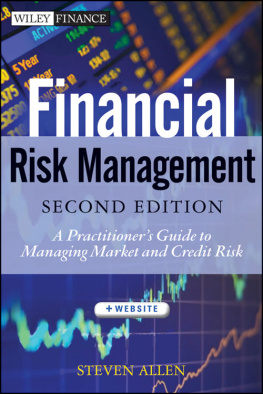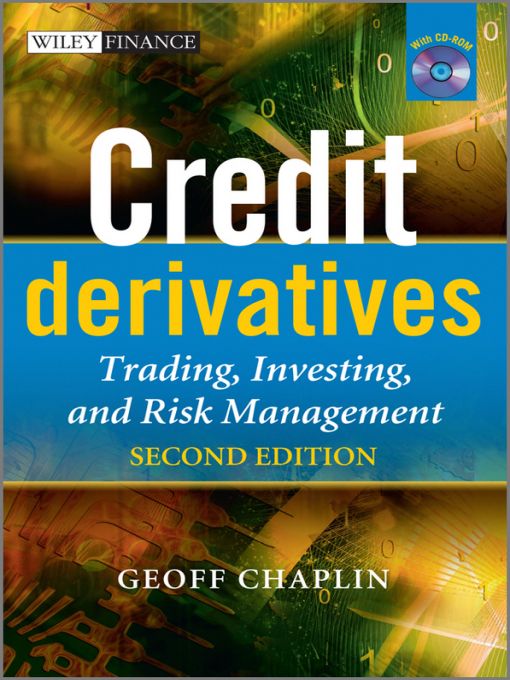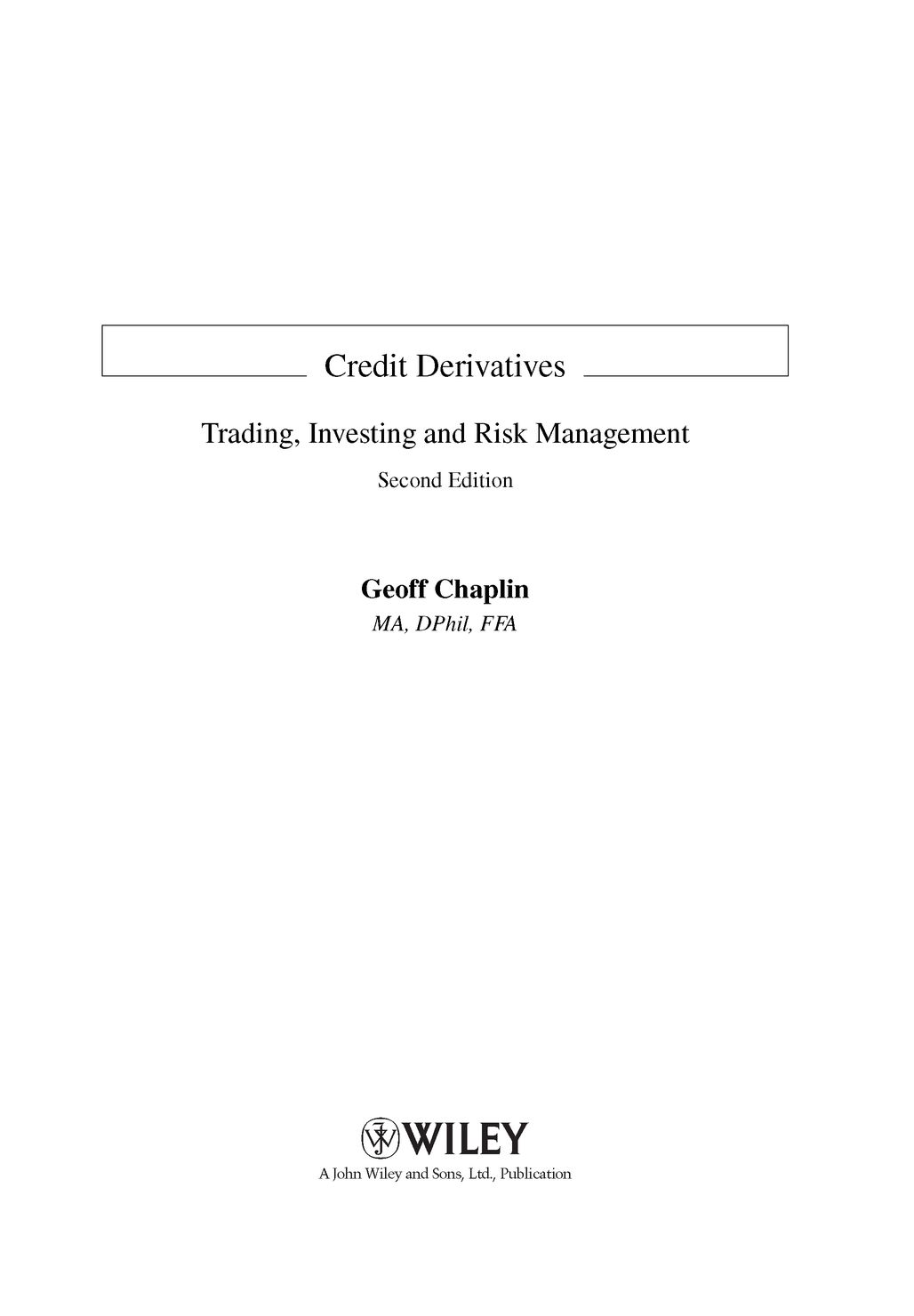Table of Contents
For other titles in the Wiley Finance series please see www.wiley.com/finance
To my parents, my partner and my children
Preface to the First Edition
This book arose out of several courses and training sessions given to finance professionals. Those courses, and this book, are aimed at traders in the credit and other derivatives, quants wishing to develop some product knowledge in this area, risk managers including the corporate treasurer, investors and others requiring both product knowledge and a grasp of valuation and risk. The aim is to develop an understanding of the various credit derivatives products. In order to achieve this it is necessary for the reader to have a certain amount of financial background - and a certain level of maturity when it comes to understanding structured products and the management of a portfolio of risks. I have tried to cover key credit background in Part I of the book. Readers with experience in this area can skip through most of the topics covered here - though generally the role of repo, and the difference between asset swap spreads and z-spreads, do not appear to be well understood, and the reader is advised to study these sections at least. Other areas that may be unfamiliar are the calibration of transition matrices to market data (spreads and volatilities), and the generation of correlated spread moves using the Normal Copula.
The most common credit derivative product is the credit default swap (CDS), and this is covered along with other single name credit derivatives in Part II. A relatively simple deterministic pricing model is described, together with a stochastic model in section 9.4. A model is of little use without data, and various data-related issues are discussed, together with detailed analysis of model shortcomings, potential improvements, and the setting of reserves. Chapters 10 to 12 analyse a variety of trades: credit curve trades, cross-currency hedges, spread and event risk, valuation and unwind of default swap positions, and a detailed breakdown of the basis between CDS premiums and bond spreads. Non-vanilla default swaps, options, and total return swaps are also covered in Part II. Chapter 17 draws together many of the aspects of valuation, risk calculation and hedging with a discussion of book management applied to the single name credit risk book. Finally we end this section with a look at pricing single name default swaps via default time simulation. This introduces some of the techniques used in analysing portfolio products in the relatively simple context of default swaps.
Part III looks at nth-to-default products and CDOs. The latter form a very extensive topic in their own right: I have given a descriptive analysis of many of the different types of CDO structure, and product applications though, when it comes to using the pricing model, we concentrate on synthetic static CDOs (including standard CDO products such as iTraxx). Nevertheless the model described is appropriate to both the standardised products and the more complex waterfall structures seen in some cashflow CDOs. Examples are given to develop an intuitive understanding of the correlated default time modelling approach, and of default time correlation. This part quotes valuation results extensively to illustrate important points. In addition, software provided allows the user to reproduce quoted results and to experiment with different portfolios, structures and situations to learn more about both the product and the consequences of the modelling approach. Product risks and model deficiencies are discussed in detail as is the question of reserves. A section is devoted to the correlation matrix. The preferred interpretation of the model is as an interpolation rule, driven by market prices - giving rise to implied correlation - and then applied to non-traded products. Implied (compound) correlation and base correlations are covered here. Alternative Copulas are discussed and applied. This part concludes with a discussion of the management of a portfolio of correlation products and high- and low-risk hedging techniques.
We revisit the topic of single name credit default swaps in Part IV where we take account of counterparty risk. In addition, the topic of protection on counterparties is briefly covered.
In writing the book I have been conscious that CDO products, and methods of analysis, have been developing rapidly. Although the book is illustrated using some of these products, their precise form has changed in the past and will continue to change in the future. I have not been able to cover all aspects of credit derivatives - neither equity default swaps nor constant maturity default swaps have been discussed, and some model approaches have not been covered (for example claim of market value models, and blended correlation). I have chosen to concentrate on core products, general principles and features that are likely to continue to apply in the future. Nevertheless the book reflects the situation at the time of writing (late 2004): products, methodologies and interpretations will evolve.
Throughout the book I have tried to illustrate ideas and principles using real world examples. In addition there are a variety of thought experiments and exercises to encourage the reader to test theories against real life, and to develop a deeper understanding of the various concepts through their application. A prerequisite to effective application and management of credit derivative positions is an understanding of the products, and an ability to discuss those products in a meaningful way. This book is intended to help in this process and is therefore not aimed solely at the trader, or the risk manager, or the investor, but is intended to be read by all. Consequently I have tried to separate the mathematics from product discussion and application. Of course a good understanding of one cannot be achieved without some understanding of the other. To this end I have used as simple a version of the theory as possible, yet one which is capable of capturing the key aspects of the problem. Generally simplifications amount to ignoring the details of premium payment (frequency and day-count conventions) and often using a constant hazard rate curve. I have also given many calculated results to illustrate points arising out of the theory, and provided software to allow the reader to examine the implications of the model.
Preface to the Second Edition
In writing the second edition I have tried to keep to the objectives and style of the first edition while updating the content and, additionally, broadening the standpoint from which the book is written. Specifically, the examples have been updated and enhanced, and Parts I and II have been amended where relevant to bring them up to date. Additional text has been included to cover syndicated loans, LCDS, up-front premiums, and other changes to the CDS market, and further background has been included in Part I on terminology, investment perspectives and the credit crunch. Part III has been restructured and largely rewritten, including material on LCDOs, cashflow CDOs and structurings as well as significantly enhanced descriptions of the standard and bespoke CDO products and valuation and risk methodology. New sections (Part V and VI) have been added covering aspects of model testing and implementation, and the credit crisis respectively.
Acknowledgements






